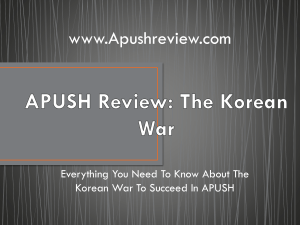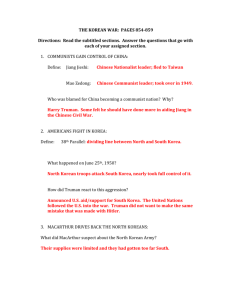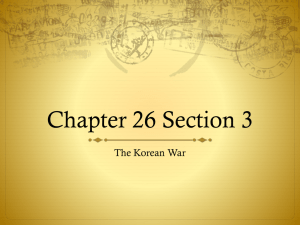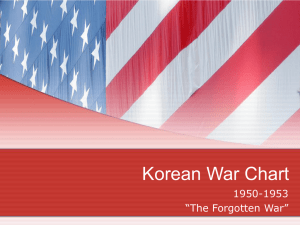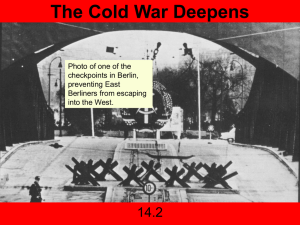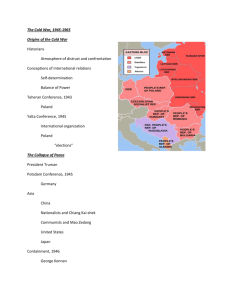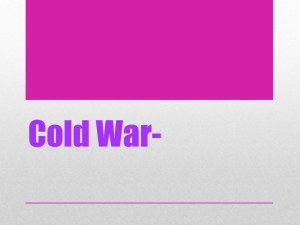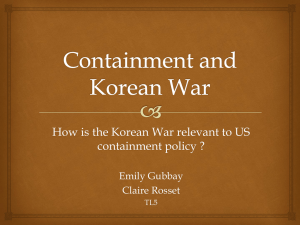U.S. History 18-2
advertisement
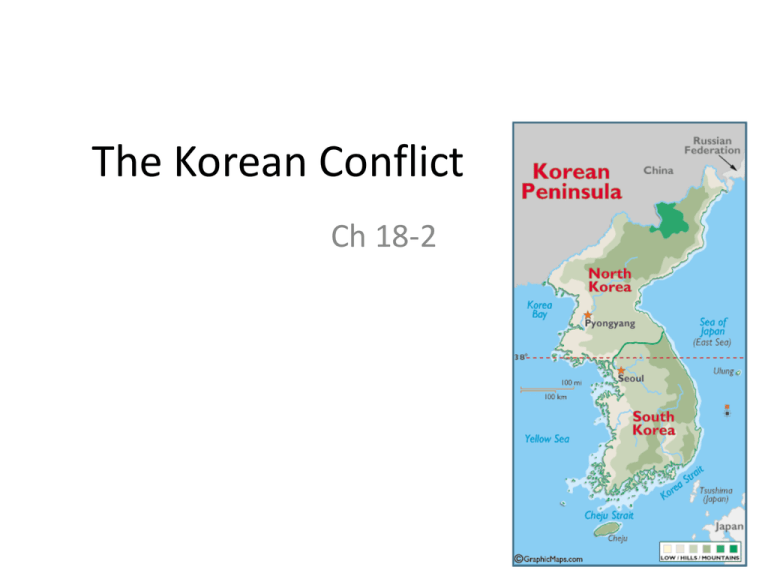
The Korean Conflict Ch 18-2 Learning Targets • 1. 2. 3. I can……………………………. Summarize the reasons for the start of the Korean War. Describe U.S. reaction to communist aggression in China. Analyze the reasons that some considered Containment to be ineffective. 4. Explain the outcome of the Korean War. China Falls to communism • In 1949, Mao Zedong and his communist supporters defeated Chiang Kai Shek (Jiang Jishi) • Shek had received billions of dollars of aid from the U.S. and many considered this a failure and a waste. • Mao renamed China, The Peoples Republic of China and turned to the USSR for aid The U.S. reaction • President Truman was considered to be too soft on communism and containment policies were questioned. • Chiang Kai Shek and his nationalist supporters fled to the island of Taiwan and formed a new nation. The U.S. rejected Mao and his government as the true government of China. • The U.N. also failed to recognize Mao and his government as legitimate. The Korean Conflict • Following Japan’s defeat in WWII, it was forced to give up Korea as a colony. • Because neither the USSR or USA could decide on which form of government should exist in Korea, it was divided on the 38th parallel. • North Korea= USSR backed communist government • South Korea= democratic pro U.S. government. The 38th parallel The start of the war • North Korea’s government reached out to China and the USSR for help in reuniting Korea as a communist government. • The USSR provided aid, weapons and intelligence for the planned invasion. • On June 25th, 1950. North Korea invaded South Korea and pushed South Korean forces to the brink of defeat within weeks. North Korea’s invasion The U.S. response • The U.S. immediately sent in 500 troops to try to stop the invasion, but they too were overrun. • The U.S. appealed to the U.N. for authorization to take force and it agreed. (China and USSR absent from vote) • The U.N. sent in an army of over 590,000 troops and made WWII hero Douglas MacArthur commander of forces. MacArthur’s brilliant move • North Korea expected a U.S. attack at Pusan but MacArthur instead stunned North Korea with an attack at Inchon. (Inchon landing) • This risky move worked and cut N. Korean lines in half. The tide of the war turns • The U.N. troops pushed North Korean troops out of South Korea and near the Chinese border by November. Many thought the war would soon be over. Chinese intervention • In late November of 1950, China sent in over 300,000 troops to drive back the U.N. army. (they feared a U.S. invasion) • With China in the war, U.N. troops were pushed all the way back across the 38th parallel and Seoul was captured by the communists. MacArthur and Truman feud • MacArthur wanted the use atomic weapons and invade China, Truman refused. • MacArthur was summoned by the President to a meeting where he was ordered to stop talking to the press. • When MacArthur pushed the atomic bomb issue to the press, Truman reacted by dismissing him as commander. • General Matthew Ridgeway took command and stabilized the war effort by pushing China and North Korea back to the 38th parallel. The War ends in a stalemate • New U.S. president Dwight D. Eisenhower presided over a ceasefire between the two sides. • After three years and 54,000 American lives and over one million Korean deaths along with 67 billion dollars, the war ended in a ceasefire. • The lines were nearly identical to what they were prior to the start of the war. • Many people viewed the war as another failure of American policy because we did not unite Korea as a democratic nation.
